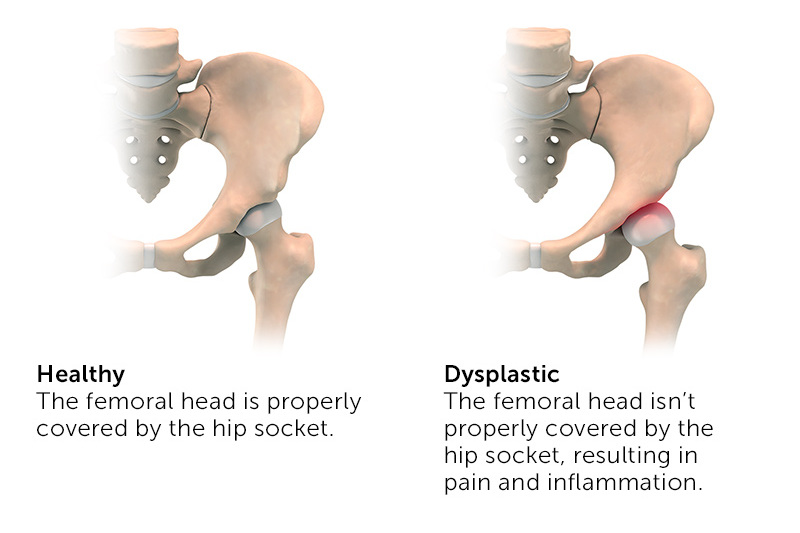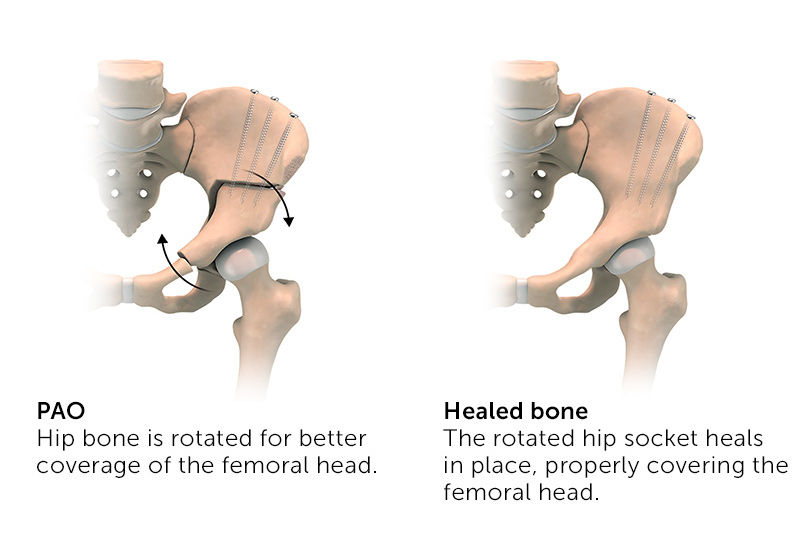What is a periacetabular osteotomy?
Periacetabular osteotomy (PAO) is a surgical procedure that changes the angle of the hip socket so that the ball-shaped femoral head fits more securely inside of it.
What is PAO surgery for?
A periacetabular osteotomy (PAO) is the main surgical treatment for adolescents and young adults with hip dysplasia who experience hip pain and are limited in their daily function. The long-term goal of the procedure is to preserve the hip joint and decrease the risk of developing arthritis. In the short term, PAO can restore hip stability, reduce hip pain, and improve function.
If a PAO is performed before advanced hip arthritis is present, it may serve as a lifelong treatment.

A healthy hip compared to a hip with dysplasia.
What happens during PAO surgery?
During PAO, the hip preservation orthopedic surgeon makes a series of cuts to the bone (osteotomies) around the hip socket to rotate the socket into proper position. Once the socket is repositioned, the surgeon inserts metal screws to hold the bone in place while it heals.

PAO surgery and recovery
The goal of this procedure is to allow the hip socket to provide better coverage of the top of the femur (femoral head) and reduce stress on the rim of the hip socket (acetabulum) that otherwise causes cartilage damage.
If a patient also has a labral tear — a tear in the cartilage surrounding the hip joint that sometimes accompanies hip dysplasia — their PAO may be combined with a procedure called hip arthroscopy. Arthroscopy allows the surgeon to work inside the joint to repair the damaged cartilage and the labrum.
Is there an ideal age for PAO surgery?
PAO is an option for children after they reach skeletal maturity. It is typically performed on patients between the ages of 12 and 40. However, our hip preservation specialists at Boston Children’s Hospital have experience performing PAO in patients younger than 12 and older than 40.
See how PAO surgery helped this triathlete return to her passion after hip pain nearly ended her athletic career.
What is recovery from PAO surgery like?
Patients usually begin physical therapy (PT) the day after surgery, starting with range-of-motion exercises. PT begins with walking, first with parallel bars and then with crutches. Patients who have stairs at home will work on going up and down the stairs before leaving the hospital.
After PAO, patients are discharged with a home exercise program. Over the next several weeks and months, patients gradually regain strength and are typically able to start outpatient physical therapy around one month after the PAO.
Crutches are very important for the first several weeks after PAO while the bone is fully healing. Most patients use crutches for two months post-surgery.
After the hip has healed, most patients are able to return to their highest previous level of activity. Many of our patients return to competitive sports after PAO, although each individual’s interest and level of activity is different.
How we approach PAO surgery
The hip specialists in the Child and Young Adult Hip Preservation Program at Boston Children’s have performed more PAO surgeries than any other hospital in the nation. Our specialists have led the way in innovations to the PAO surgical technique, including the development of muscle-sparing techniques that preserve the musculature around the hip and aid in the return to activities and reducing pain after PAO.
In all cases, the decision-making process between our patients and their specialist is one of open and honest communication. For patients who, along with their physician, choose PAO surgery, we expect their pain and function will be greatly improved by the surgery for many years.
Further, patients who choose Boston Children’s for PAO surgery have access to the vast range of services and expertise the hospital has to offer. Our hip preservation surgeons work closely with the departments of Nursing, Anesthesiology, Critical Care and Pain Medicine, Sports Medicine, and Radiology so our patients can receive the most comprehensive care possible. After surgery, we work with therapists in the Department of Physical Therapy and Occupational Therapy Services to help get patients back to being active and pain-free.
Periacetabular Osteotomy (PAO) | Programs & Services
Programs
Child and Young Adult Hip Preservation Program
Program
The Child and Young Adult Hip Preservation Program serves children and young adults with common and complex hip disorders.
Learn more about Child and Young Adult Hip Preservation Program
Departments
Sports Medicine Division
Department
The Pediatric Sports Medicine Division provides comprehensive care to athletes of all ages and abilities, from professional athletes to eager novices.
Radiology
Department
The Department of Radiology provides a full range of imaging services for newborns, infants, children, teenagers, young adults, and pregnant women.
Physical Therapy and Occupational Therapy Services
Department
Physical Therapy and Occupational Therapy Services offers services intended to improve the quality of life of our patients.
Learn more about Physical Therapy and Occupational Therapy Services
Anesthesiology, Critical Care and Pain Medicine
Department
The Department of Anesthesiology, Critical Care and Pain Medicine provides state-of-the art care in all aspects of anesthesia, perioperative medicine, critical care, and pain management.
Learn more about Anesthesiology, Critical Care and Pain Medicine
Centers
Orthopedic Center
Center
Established in 1903, we are one of the world’s most experienced pediatric orthopedic centers. Learn more.


